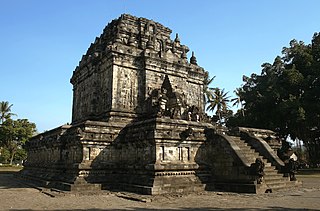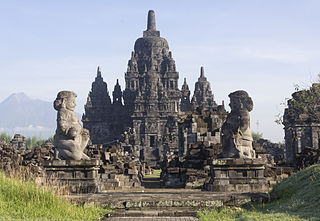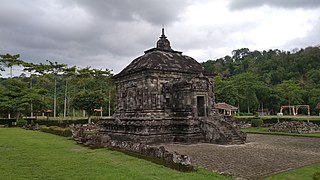
Borobudur, also transcribed Barabudur is a 9th-century Mahayana Buddhist temple in Magelang Regency, not far from the town of Muntilan, in Central Java, Indonesia. It is the world's largest Buddhist temple. The temple consists of nine stacked platforms, six square and three circular, topped by a central dome. It is decorated with 2,672 relief panels and originally 504 Buddha statues. The central dome is surrounded by 72 Buddha statues, each seated inside a perforated stupa.

Prambanan is a 9th-century Hindu temple compound in Special Region of Yogyakarta, Indonesia, dedicated to the Trimūrti, the expression of God as the Creator (Brahma), the Preserver (Vishnu) and the Destroyer (Shiva). The temple compound is located approximately 17 kilometres (11 mi) northeast of the city of Yogyakarta on the boundary between Central Java and Yogyakarta provinces.

Kalasan, also known as Candi Kalibening, is an 8th-century Buddhist temple in Java, Indonesia. It is located 13 kilometers (8.1 mi) east of Yogyakarta on the way to Prambanan temple, on the south side of the main road Jalan Solo between Yogyakarta and Surakarta. Administratively, it is located in the Kalasan District (kapanewon) of Sleman Regency.

A candi is a Hindu or Buddhist temple in Indonesia, mostly built during the Zaman Hindu-Buddha or "Hindu-Buddhist period" between circa the 4th and 15th centuries.

Pawon is a Buddhist temple in Central Java, Indonesia.

Mendut is a ninth-century Buddhist temple, located in Mendut village, Mungkid sub-district, Magelang Regency, Central Java, Indonesia. The temple is located about three kilometres east from Borobudur. Mendut, Borobudur and Pawon, all of which are Buddhist temples, are located in one straight line. There is a mutual religious relationship between the three temples, although the exact ritual process is unknown.

Candi Plaosan, also known as the 'Plaosan Complex', is one of the Buddhist temples located in Bugisan village, Prambanan district, Klaten Regency, Central Java, Indonesia, about 1 kilometre to the northeast of the renowned Hindu Prambanan Temple.

Sewu is an eighth century Mahayana Buddhist temple located 800 metres north of Prambanan in Central Java, Indonesia. The word for a Hindu or Buddhist temple in Indonesian is "candi," hence the common name is "Candi Sewu." Candi Sewu is the second largest Buddhist temple complex in Indonesia; Borobudur is the largest. Sewu predates nearby "Loro Jonggrang" temple at Prambanan. Although the complex consists of 249 temples, this Javanese name translates to 'a thousand temples,' which originated from popular local folklore. Archaeologists believe the original name for the temple compound to be Manjusrigrha.

The Sari Temple is an 8th-century Buddhist temple located at Dusun Bendan, Tirtomartani village, Kalasan, Sleman Regency, Special Region of Yogyakarta, Indonesia. It is located about 130 meters (430 ft) northeast of the Kalasan temple. The temple was a two-story building with wooden beams, floors, stairs completed with windows and doors; all from organic materials which now are decayed and gone. It is suggested that the original function of this building was a vihara, a dwelling place for monks. The temple's name Sari or Saré translates as "to sleep" in Javanese, which also confirms the habitation nature of the building.

Prambanan Temple Compounds is the World Heritage designation of a group of Hindu temple compounds that lie on the border between Yogyakarta and Central Java, Indonesia. It comprises Prambanan, Lumbung, Bubrah and Sewu temple compounds, all are located within Prambanan Archaeological Park.

Sambisari is a 9th-century Hindu temple located at Sambisari hamlet, Purwomartani, Kalasan, Sleman Regency, Special Region of Yogyakarta, Indonesia. The temple was buried about five metres underground. Parts of the original temple have been excavated. The temple is located about 8 kilometres (5.0 mi) east of Yogyakarta near Adisucipto International Airport.

Kewu Plain, also known as Prambanan Plain or Opak River valley, is a fertile volcanic plain that lies between Merapi-Merbabu complex in the north, Bantul lowlands and Sewu karst limestone range in the south, Bengawan Solo river valley in east, and the Progo River in the west, and Kedu Plain on northwest. It is located within the Yogyakarta Special Region, Sleman Regency, Klaten Regency and Solo City, Indonesia.

Sojiwan is a 9th-century Mahayana Buddhist temple located in Kebon Dalem Kidul village, Prambanan, Klaten Regency, Central Java. The temple is located nearly two kilometres southeast of Prambanan temple. This temple is among numbers of temples scattered in Prambanan Plain.

Ijo temple is a Hindu candi (temple) located 4 kilometers from Ratu Boko or around 18 kilometers east from Yogyakarta, Indonesia. The temple was built between 10th to 11th century CE during the Mataram Kingdom period.

Merak temple, or locally known as Candi Merak, is a 10th-century Javanese Shivaist Hindu temple complex located in Karangnongko village, in Klaten Regency, northwest from Klaten town, Central Java, on southeastern slopes of Mount Merapi. The temple complex consisted of a main building and three perwara (ancillary) temples, dating from the 9th or 10th century, from the Mataram Kingdom.

Ngawen is an 8th-century Buddhist temple compound in Magelang Regency, Central Java, Indonesia. Located in Ngawen village, Muntilan sub-district, 6 km (3.7 mi) to the east of Mendut temple or 5 km (3.1 mi) to the south of Muntilan town center. Ngawen temple compound consists of five temples, however today only one is successfully reconstructed.

Dieng temples is the group of 7th and/or eighth century Hindu candi or temple compounds located in Dieng Plateau, near Banjarnegara, Central Java, Indonesia. These edifices originate from the Kalingga Kingdom. The plateau is home of eight small Hindu temples that are among the oldest surviving religious structures ever built in Java, and the earliest Hindu temples in Indonesia. The temples show many features of Indian Hindu temple architecture.

Barong temple is a 9th-century Hindu candi (temple) located approximately 800 meters east-southeast from Ratu Boko compound. The temple is located on a hill in Candisari hamlet, Bokoharjo village, Prambanan subdistrict, Sleman Regency, Yogyakarta, Indonesia. The temple is named barong according to its kala's head carving on top of the niches of its temples that resembles Barong.

Bubrah is a 9th-century Buddhist temple located within the complex of the Prambanan Temple Archaeological Park, in Central Java, Indonesia. Experts believe that the temple was designed as a part of the greater Sewu temple compound.

Badut is an 8th-century Hindu candi (temple) located in Tidar area around 5 kilometres west from the center of Malang city. This andesite stone structure is located in Karang Besuki village, Dau subdistrict, Malang Regency, East Java Indonesia.


























